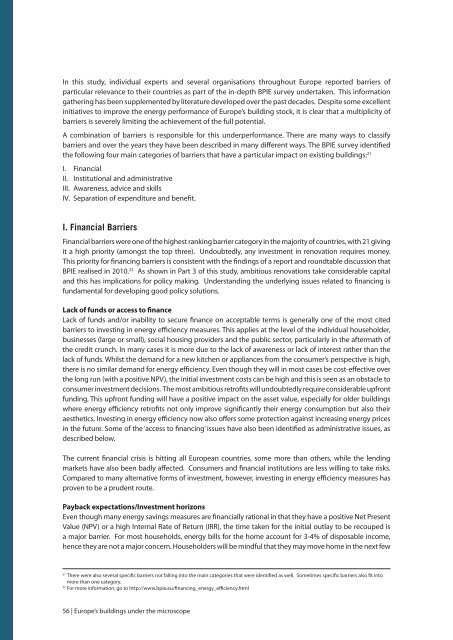BPIE: Europe's buildings under the microscope - PU Europe
BPIE: Europe's buildings under the microscope - PU Europe
BPIE: Europe's buildings under the microscope - PU Europe
Create successful ePaper yourself
Turn your PDF publications into a flip-book with our unique Google optimized e-Paper software.
In this study, individual experts and several organisations throughout <strong>Europe</strong> reported barriers of<br />
particular relevance to <strong>the</strong>ir countries as part of <strong>the</strong> in-depth <strong>BPIE</strong> survey <strong>under</strong>taken. This information<br />
ga<strong>the</strong>ring has been supplemented by literature developed over <strong>the</strong> past decades. Despite some excellent<br />
initiatives to improve <strong>the</strong> energy performance of <strong>Europe</strong>’s building stock, it is clear that a multiplicity of<br />
barriers is severely limiting <strong>the</strong> achievement of <strong>the</strong> full potential.<br />
A combination of barriers is responsible for this <strong>under</strong>performance. There are many ways to classify<br />
barriers and over <strong>the</strong> years <strong>the</strong>y have been described in many different ways. The <strong>BPIE</strong> survey identified<br />
<strong>the</strong> following four main categories of barriers that have a particular impact on existing <strong>buildings</strong>: 21<br />
I. Financial<br />
II. Institutional and administrative<br />
III. Awareness, advice and skills<br />
IV. Separation of expenditure and benefit.<br />
I. Financial Barriers<br />
Financial barriers were one of <strong>the</strong> highest ranking barrier category in <strong>the</strong> majority of countries, with 21 giving<br />
it a high priority (amongst <strong>the</strong> top three). Undoubtedly, any investment in renovation requires money.<br />
This priority for financing barriers is consistent with <strong>the</strong> findings of a report and roundtable discussion that<br />
<strong>BPIE</strong> realised in 2010. 22 As shown in Part 3 of this study, ambitious renovations take considerable capital<br />
and this has implications for policy making. Understanding <strong>the</strong> <strong>under</strong>lying issues related to financing is<br />
fundamental for developing good policy solutions.<br />
Lack of funds or access to finance<br />
Lack of funds and/or inability to secure finance on acceptable terms is generally one of <strong>the</strong> most cited<br />
barriers to investing in energy efficiency measures. This applies at <strong>the</strong> level of <strong>the</strong> individual householder,<br />
businesses (large or small), social housing providers and <strong>the</strong> public sector, particularly in <strong>the</strong> aftermath of<br />
<strong>the</strong> credit crunch. In many cases it is more due to <strong>the</strong> lack of awareness or lack of interest ra<strong>the</strong>r than <strong>the</strong><br />
lack of funds. Whilst <strong>the</strong> demand for a new kitchen or appliances from <strong>the</strong> consumer’s perspective is high,<br />
<strong>the</strong>re is no similar demand for energy efficiency. Even though <strong>the</strong>y will in most cases be cost-effective over<br />
<strong>the</strong> long run (with a positive NPV), <strong>the</strong> initial investment costs can be high and this is seen as an obstacle to<br />
consumer investment decisions. The most ambitious retrofits will undoubtedly require considerable upfront<br />
funding. This upfront funding will have a positive impact on <strong>the</strong> asset value, especially for older <strong>buildings</strong><br />
where energy efficiency retrofits not only improve significantly <strong>the</strong>ir energy consumption but also <strong>the</strong>ir<br />
aes<strong>the</strong>tics. Investing in energy efficiency now also offers some protection against increasing energy prices<br />
in <strong>the</strong> future. Some of <strong>the</strong> ‘access to financing’ issues have also been identified as administrative issues, as<br />
described below.<br />
The current financial crisis is hitting all <strong>Europe</strong>an countries, some more than o<strong>the</strong>rs, while <strong>the</strong> lending<br />
markets have also been badly affected. Consumers and financial institutions are less willing to take risks.<br />
Compared to many alternative forms of investment, however, investing in energy efficiency measures has<br />
proven to be a prudent route.<br />
Payback expectations/Investment horizons<br />
Even though many energy savings measures are financially rational in that <strong>the</strong>y have a positive Net Present<br />
Value (NPV) or a high Internal Rate of Return (IRR), <strong>the</strong> time taken for <strong>the</strong> initial outlay to be recouped is<br />
a major barrier. For most households, energy bills for <strong>the</strong> home account for 3-4% of disposable income,<br />
hence <strong>the</strong>y are not a major concern. Householders will be mindful that <strong>the</strong>y may move home in <strong>the</strong> next few<br />
21<br />
There were also several specific barriers not falling into <strong>the</strong> main categories that were identified as well. Sometimes specific barriers also fit into<br />
more than one category.<br />
22<br />
For more information, go to http://www.bpie.eu/financing_energy_efficiency.html<br />
56 | <strong>Europe</strong>’s <strong>buildings</strong> <strong>under</strong> <strong>the</strong> <strong>microscope</strong>
















